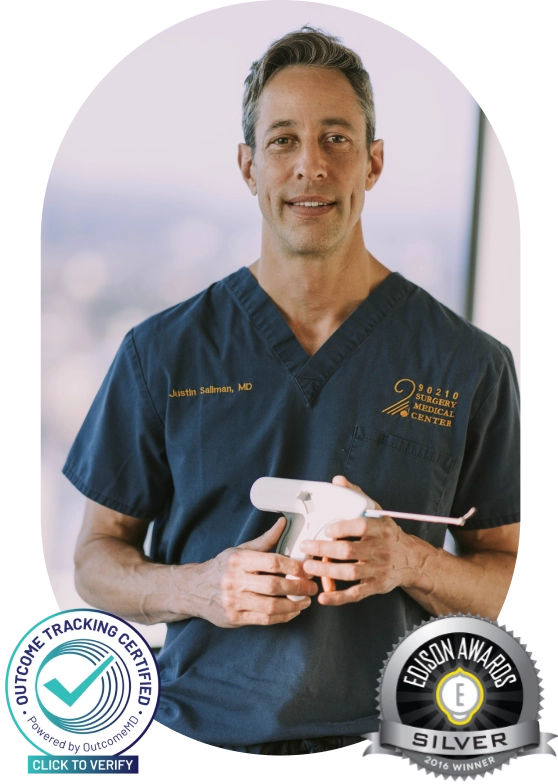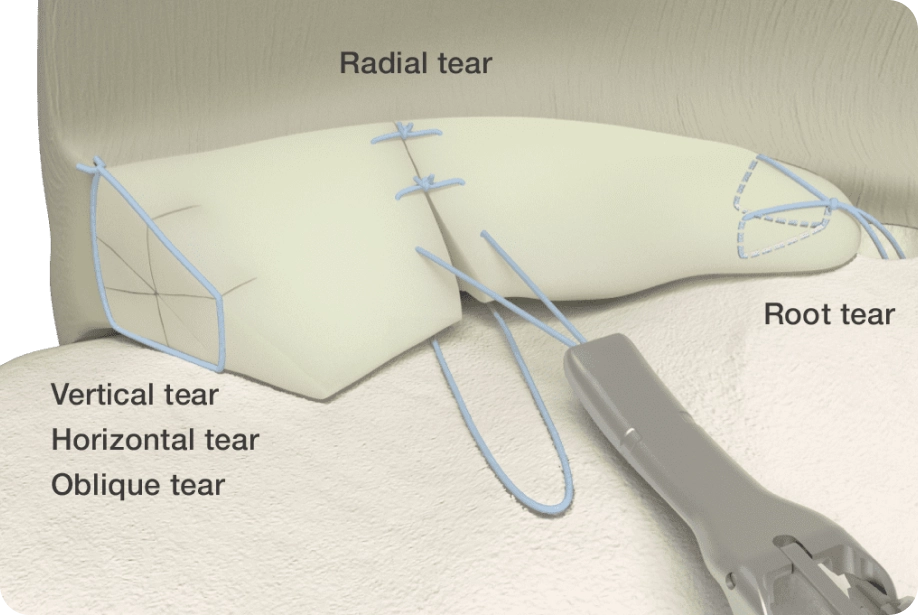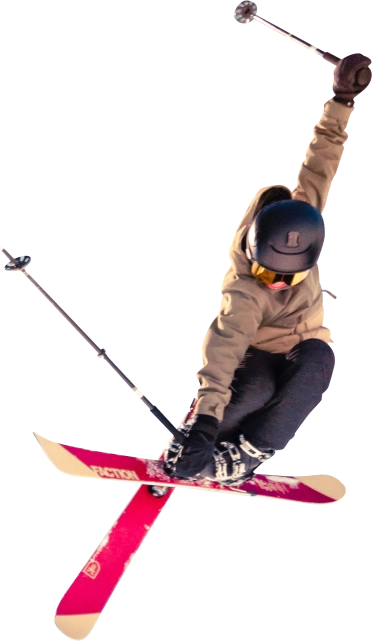Have your meniscus tear repaired by the
Horizontal Meniscus Tear Specialist

Have a horizontal meniscus tear?
Don’t let someone remove your meniscus.
SAVE YOUR MENISCUS! Living with a horizontal meniscus tear, or allowing a surgeon to remove the torn parts, significantly increases your risk for arthritis and knee replacement. Don’t let someone “trim” your horizontal tear or temporarily alleviate your symptoms with cortisone, PRP or stem cells. Have it sewn back together by the best! Justin D. Saliman, MD invented the NovoStitch® Pro Meniscal Repair System, which received FDA approval in 2012 and an Edison Award in 2015. The device passes Dr. Saliman’s patented Circumferential Stitch which is perfect for horizontal cleavage tears. Nobody has more experience passing this revolutionary stitch!
Why repair horizontal meniscus tears?
And why with the Circumferential Stitch?
Meniscus repair has been around a long time, but traditional techniques have had somewhat high failure rates and were only possible for a limited number of tear types. Horizontal tear repair has been shown to have the same healing rates as all other tears, however, surgeons often misinform patients that these tears are too “degenerative” to be successfully repaired.
New advances in meniscus repair allow surgeons to sew the top and bottom of a horizontal tear back together in ways never before possible and the results have been impressive! This is important because the meniscus spreads forces evenly within the knee joint and without its full function the knee becomes arthritic.
So why are we now able to sew horizontal cleavage tears back together? Because we can now repair with Circumferential Stitches. These stitches…
- Line up the horizontal tears edges, and uniformly compress them together during healing
- Repair the top and bottom laminas of a horizontal tear directly to each other
- Does not entrap the capsule during sewing which may allow more natural movement of the repaired meniscus
- The needle used in NovoStitch device is very small and it cuts in-line with the circumferential fibers of the meniscus.
- Other techniques have left large holes which can propagate new horizontal tears
- Passing the circumferential stitch does not require needle passes toward neurovascular structures
There is no other device that can safely and reliably pass circumferential stitches in all zones of the meniscus


Am I too old to have my horizontal tear repaired?
NO! Studies have shown that patient age is not a factor, and that the meniscus can heal in patients of all ages provided the knee is not already arthritic
I was told my tear horizontal tears were “degenerative” and could not heal because there was not a good enough blood supply?
Traditional horizontal meniscus repair techniques inadequately approximated the torn edges, leading to poor healing. Surgeons blamed the blood supply even though there is good medical literature evidence that the avascular zones heal if adequately compressed together during the healing process. See the videos on this site for additional proof!
See the following article, The Circumferential Compression Stitch for Meniscus Repair, for a better understanding of why repair your meniscus and to see the various tear types
What is a horizontal cleavage tear of the meniscus?
Your menisci are two wedge-shaped pieces of cartilage that cushion your knee joints and act as shock absorbers every time you take a step. Horizontal tears are essentially a blister that forms within the internal portions of the meniscus and eventually splits through one of the meniscal surfaces dividing your meniscus into a bottom and top half (like an open fish mouth lower and upper jaw). Without an intact meniscus, your knee joint becomes arthritic, and the only definitive treatment for an arthritic knee is total knee replacement – so, SAVE YOUR MENISCUS!
Symptoms of a horizontal meniscus tear may include one or more of the following:
- Pain with activity
- Decreased range of motion
- Stiffness and swelling
- Feeling as though your knee is catching or unstable
You will probably still be able to walk after you tear your meniscus, and in fact, many athletes stomach the pain and swelling and continue to play with a horizontal meniscal tear.
How are horizontal cleavage meniscal tears treated?
Leaving a horizontal meniscus tear within your knee increases your risk of arthritis and the eventual need for knee replacement surgery. Similarly, removal of part of your meniscus (often called “trimming,” “partial meniscectomy”, or “cleaning up”) also results in significantly reduced effectiveness of your meniscus resulting in arthritis and the possible eventual need for total knee replacement. Cortisone, PRP or even stem cell injections have not been shown to heal meniscus tears. There are simply too many forces on a horizontal meniscus tear constantly pulling it apart, hence it cannot heal well without stitches holding the top and bottom in place to resist those forces during the 6 weeks that it takes for the meniscus to heal (similar to a cast for a broken bone).
Assuming your knee is not already arthritic, your best option is to have your horizontal tear sewn back together rather than removed. However, traditional meniscus repair techniques only worked for a small fraction of the tear types, hence most orthopaedic surgeons have unfortunately embraced meniscus removal surgery. But now there’s a new option – THE CIRCUMFERENTIAL STITCH! This stitch anatomically aligns the top and bottom laminas of a horizontal tear and uniformly compresses them together during the healing process in a way never before possible. This is the secret sauce that Dr. Saliman brought to the world.
What is the NovoStitch Pro Meniscal
Repair System?
Dr. Saliman invented the NovoStitch Pro Meniscal Repair System in 2008 and then founded the start-up Ceterix® Orthopaedics in 2010 to develop the technology. The NovoStitch was approved by the FDA in 2012, received a Silver Award in the 2015 Edison Awards in the surgical tools category, and was recently purchased by a well known medical device company called Smith & Nephew.
Dr. Saliman uses his NovoStitch device to place circumferential compression stitches around meniscus tears to hold the torn edges together during healing. There is no need for removal of the tissue, which has been shown to increase the risk of future knee problems. Nobody has more experience sewing meniscus tears back together with circumferential stitches than Dr. Saliman.
For the best care of your meniscal tear from the inventor of the procedure that sews your meniscus with Circumferential Stitches, call the office of Justin D. Saliman, MD, or request an appointment online today.


“This is a great honor for our founder, Dr. Justin Saliman, and our R&D team,” said John McCutcheon, president and CEO. “We are pleased to be included with the great innovators recognized by the Edison Awards.”
Justin Saliman, Founder and Chief Medical Officer at Ceterix said: “We are excited by the growth opportunities of the NovoStitch Pro at Smith & Nephew and are proud of the impact our technology has made in developing the meniscal repair market.”
Privacy Policy | Terms & Conditions | Accessibility | Notice | Contact Us
Justin D. Saliman, MD, Los Angeles, CA
Phone (appointments):(310)703-5819
Phone (general inquiries):(310)703-5819
Address: 8436 W 3rd St, Suite 800,
Los Angeles, CA 90048
Justin D. Saliman, MD, Beverly Hills, CA
Phone (appointments):(310)703-5819
Phone (general inquiries): (310)703-5819
Address: 450 N. Roxbury Dr. , Ste 600, Beverly Hills, CA 90201

